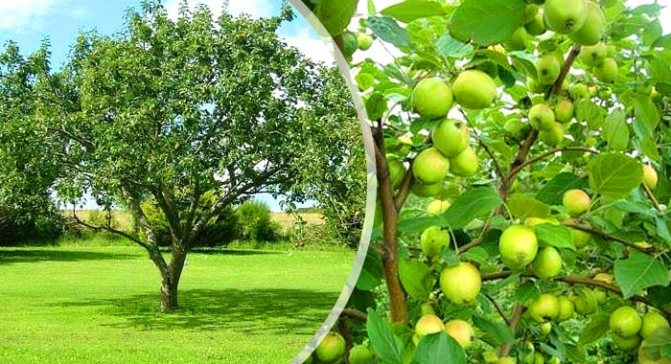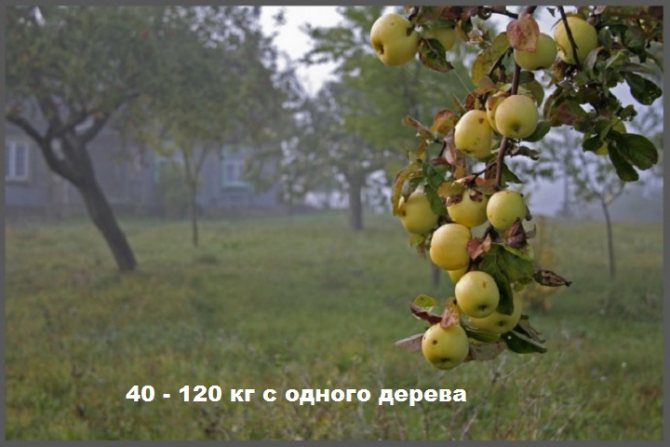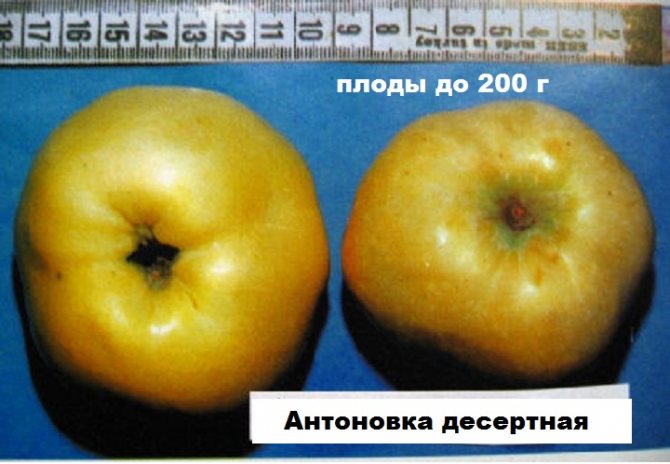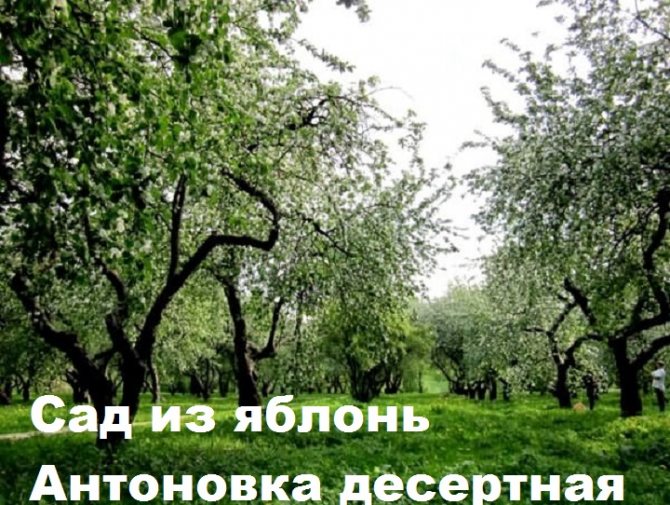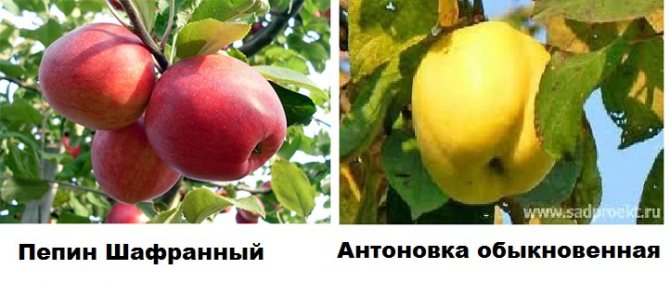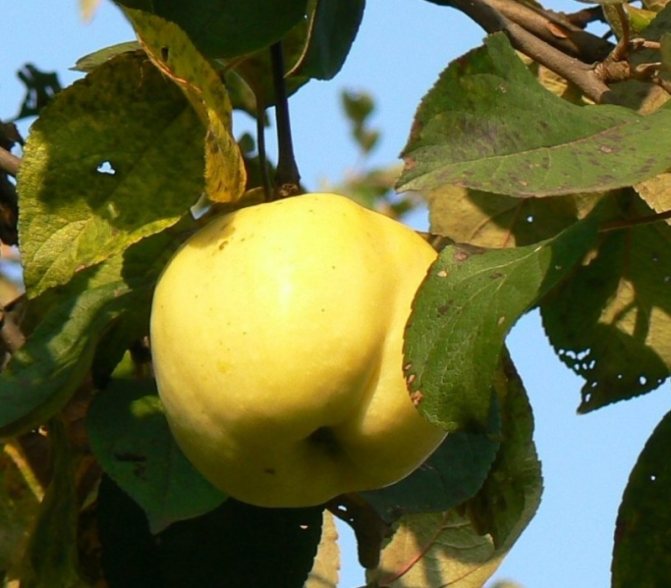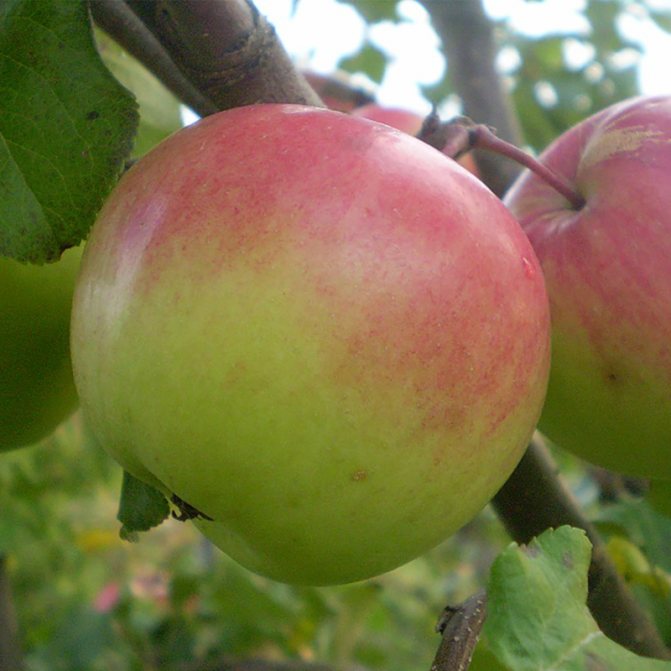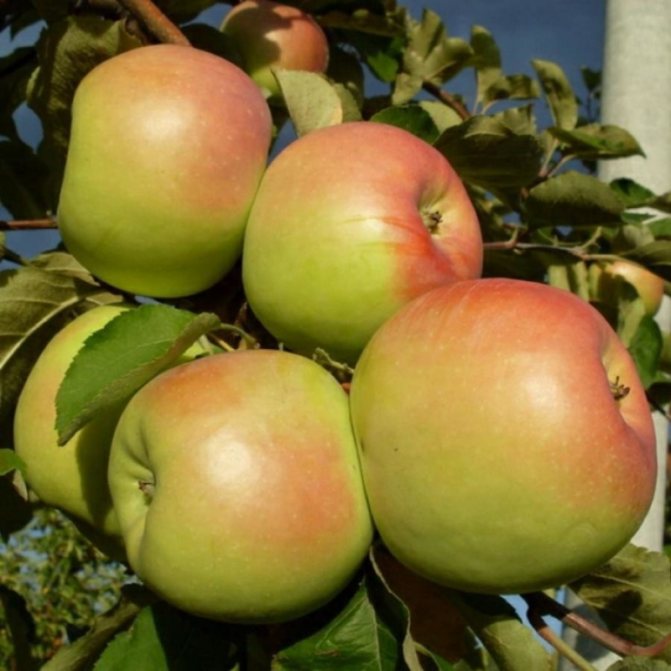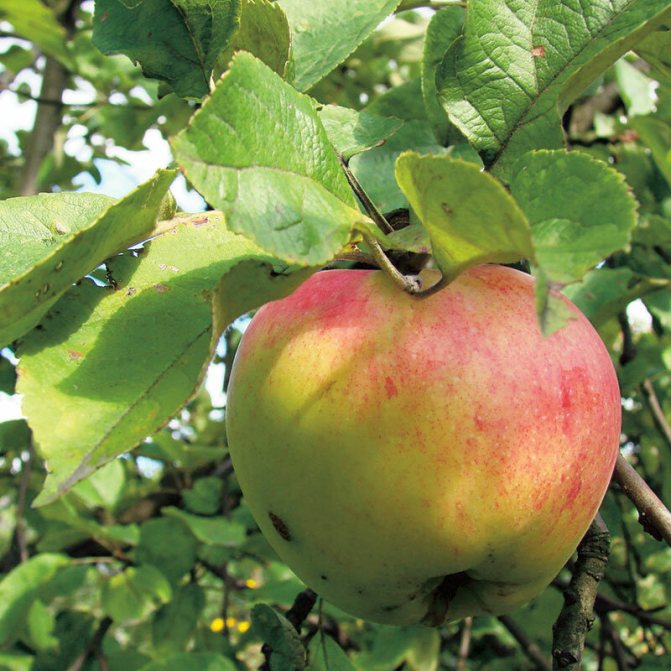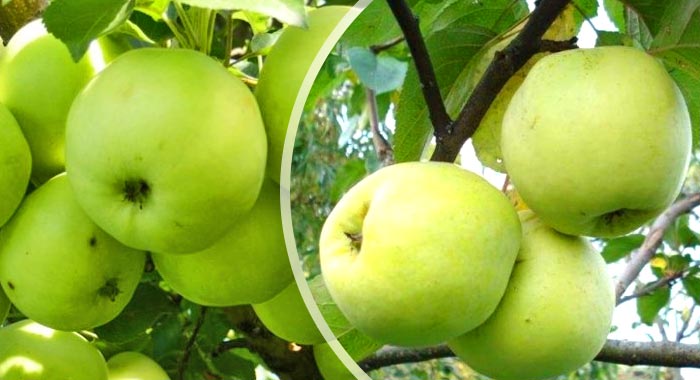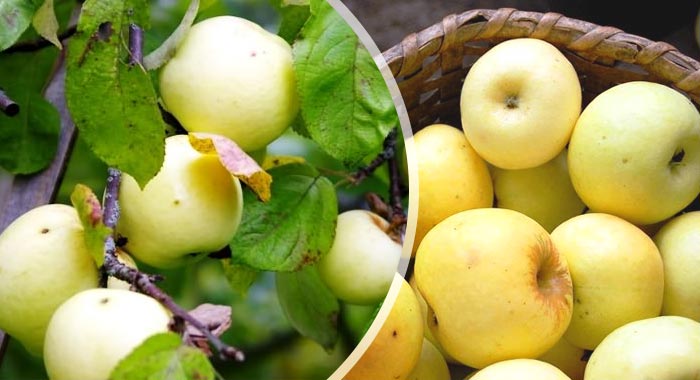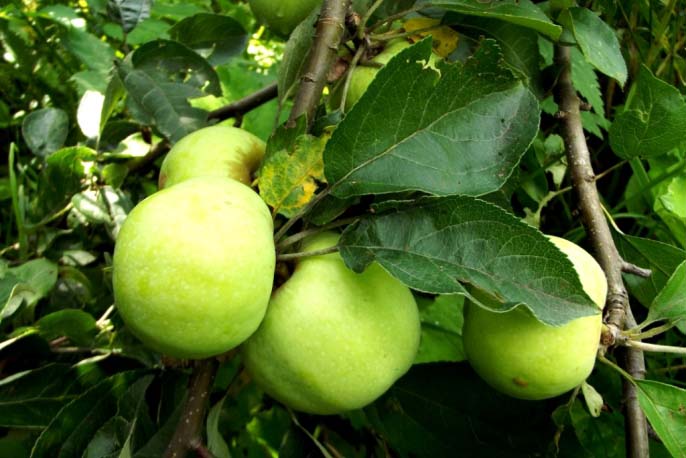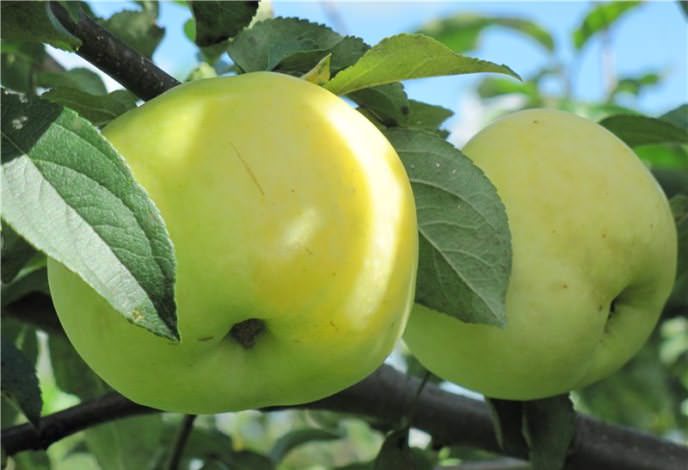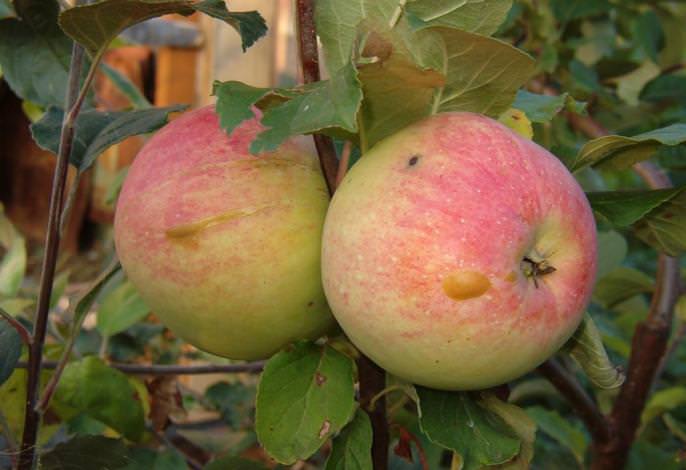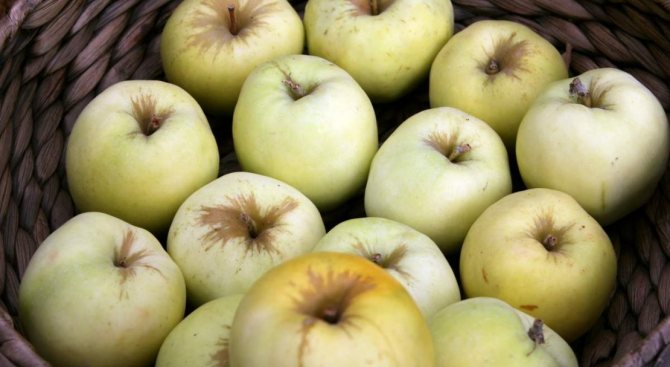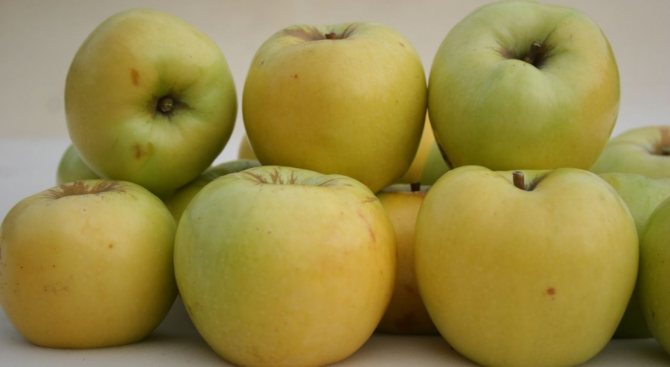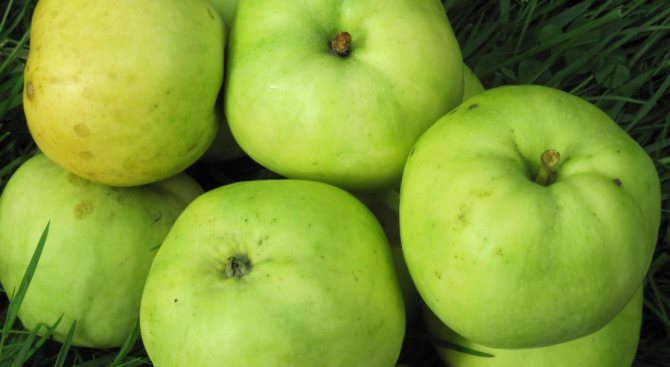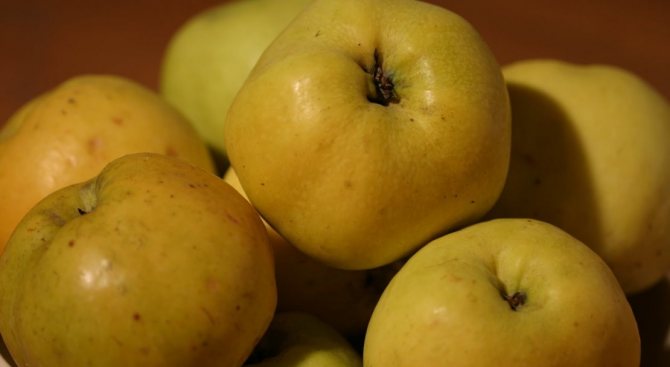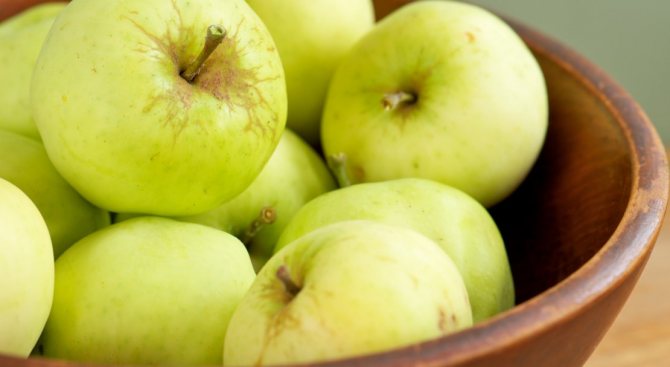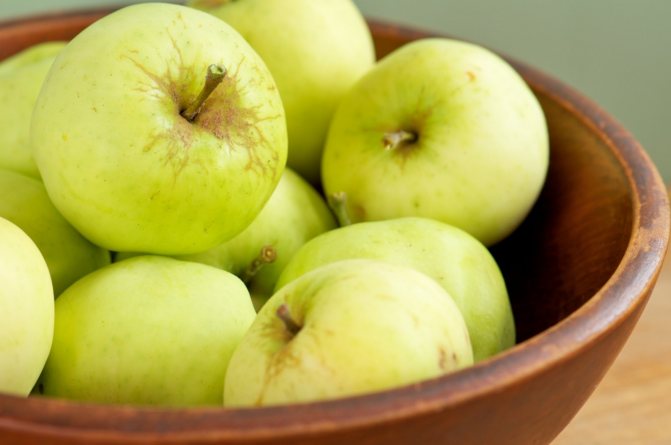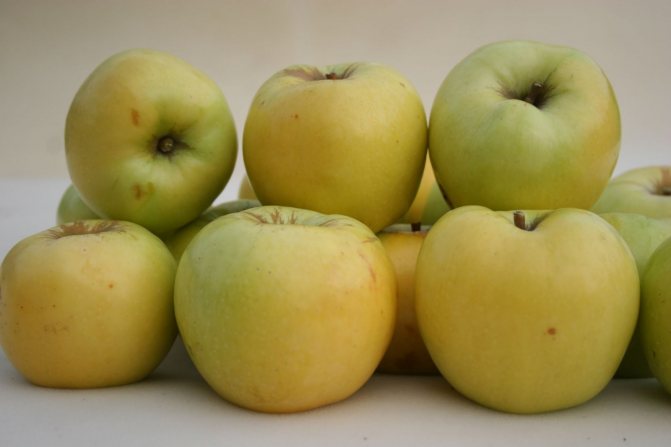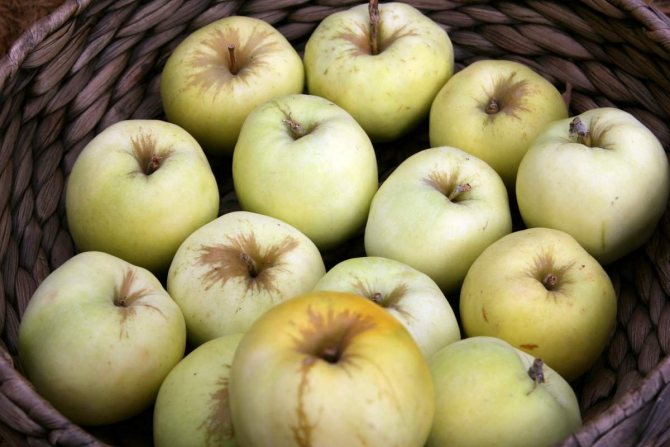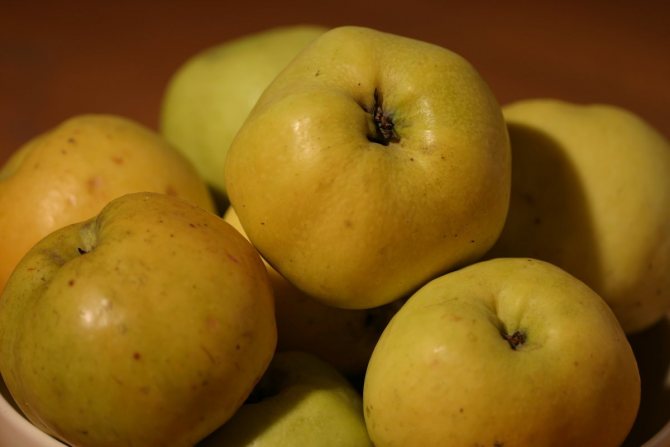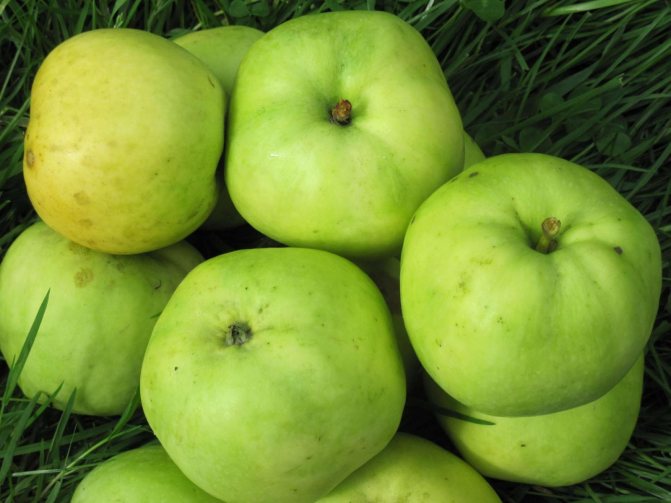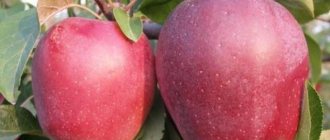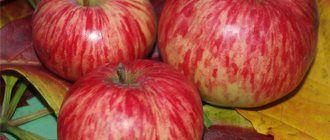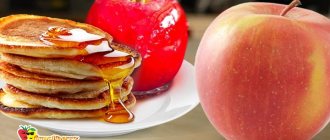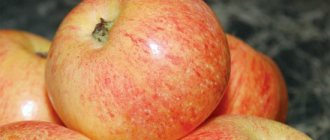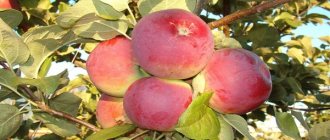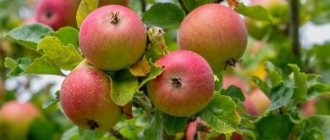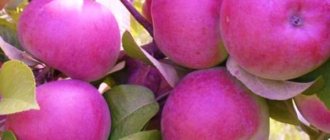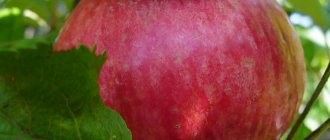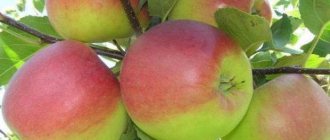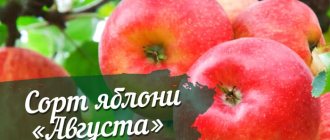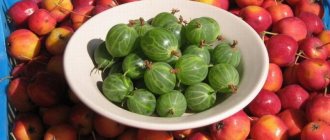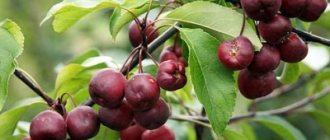Planting - not planting apple trees in your garden? I'm sure no one even asks themselves such a question when laying a garden on their site. There is no garden without apples! But which ones to plant?
You should start to get acquainted with apple varieties with White filling and Antonovka. There are few difficulties with varieties of White filling - White filling or Papirovka.
It's very interesting with Antonovka. And the older variety is not years, but centuries. And there are more questions. And in general, strictly speaking, Antonovka is an apple cultivar and combines several cultivars.
The history of the creation of the variety
It is impossible to reliably understand the details of the origin of the Antonovka variety. Some experts believe that it is an accidental hybrid of cultivars with wild ones.
The birthplace of Antonovka is the Kursk or Tula region. The first mention of the variety dates back to 1848 (NI Krasnoglazov “Rules for fruit growing in open ground, greenhouses, greenhouses). In 1896, S.V. Batov exhibited Antonovka Tulskaya in Nizhny Novgorod.
It should be noted that this plant was not described in Bolotov's registers. Later, in his work Atlas of Fruits, Grebnitsky reported that this variety has been known for a very long time, but it was not possible to find out the place of its origin.
Antonovka stood out as a separate variety in the 19th century.
Apple selection Antonovka
For the first time, Antonov apple trees are mentioned in the middle of the 19th century. the famous Moscow gardener-practitioner Krasnoglazov at that time. In his works, the scientist described Antonovka as a varietal hybrid from the Kursk province, obtained spontaneously from a forest apple. This statement is not a reliable fact, since the exact origin of the variety cannot be established. During the Soviet period, at least 7 new varieties and varieties were bred on the basis of Antonovka, modern scientists count more than 11.
Main characteristics
Apple trees of this variety are vigorous, have an oval crown, which gradually expands and becomes spreading.
As the tree matures, the main branches rise and grow to the sides. Branches and young shoots have a brown bark. The height of the tree is up to 9 meters. Fruiting is observed 6-7 years after the planting of the culture.
The leaves are bright green and oval with jagged edges. The flowers are white with pinkish notes, fragrant, large in size.
Existing species
The data collected by scientists indicate the presence of a large number of subspecies of apple trees. The main characteristics of the old and relatively new forms of Antonovka have few differences. The most common varieties are shown in the table.
| Variety | Feature |
| Antonovka Repchataya | Long-term storage of fruits |
| Antonovka Stepnaya | Grown in regions where summers are dry |
| Antonovka Belaya | Found in Belarus |
| Antonovka Sweet | Very little is stored |
| Antonovka Autumn | Lying, fruits are large |
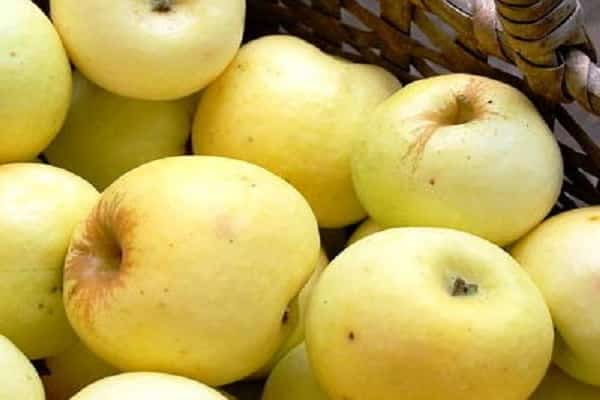
Ordinary
The fruit is rounded with ribbing. During the harvest period, the color of the apples is green, with a slight yellow tint. Antonovka's skin turns yellow during storage. The pulp is sweet and sour taste, light yellow, granular structure. The fruits of the apple tree are fragrant and sweet, the sugar content in the pulp exceeds 9%.
Advantages of Antonovka ordinary:
- winter hardiness;
- high-quality raw materials for various kinds of blanks;
- seedlings are used as a stock;
- fruits tolerate long-term transportation well;
- crumbling is low.
Disadvantages of an apple tree: medium (weak) resistance to scab pathogens, irregular fruiting.
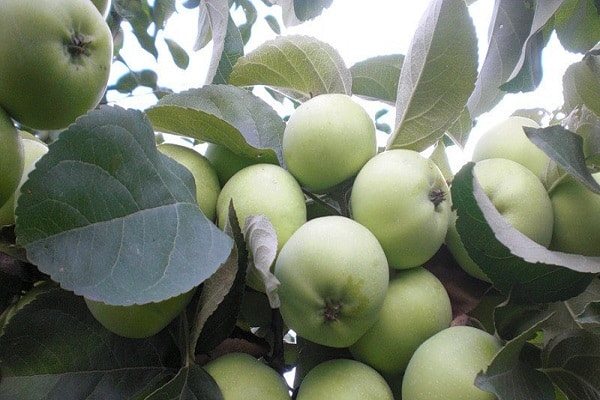

Dessert
The work of SI Isaev, he used the genetic material: Pepin Shafranny, Antonovka ordinary. Winter hybrid. The growth of the tree is average, the crown acquires a rounded shape with age, in the first years it is spherical.
The leaves, green with a yellow tint, have jagged edges along the edge. The flowers are white-pink, large. Description of fruits:
- weight 200 g;
- slightly sour taste;
- the skin is light green in color, the tint is creamy;
- the blush is red-striped;
- the pulp is fragrant.
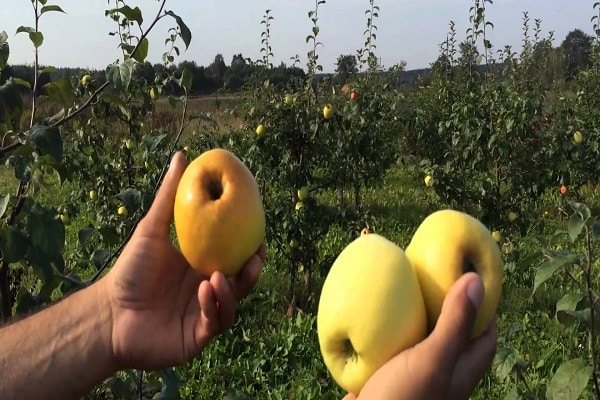

The yield is influenced by the level of agrotechnical background. On average, the yield per tree is 40-120 kg. Fruiting earlier, begins at 3 years. The fruits can be stored for up to 6 months. The resistance of the apple tree to frost is average. Regions recommended for growing Antonovka dessert:
- south of the Russian Federation;
- Central strip;
- Ukraine;
- Belarus.
In areas where winters are harsh, only frost-resistant stock is used. In the gardens of the Urals, the hybrid is grown in stanza form.
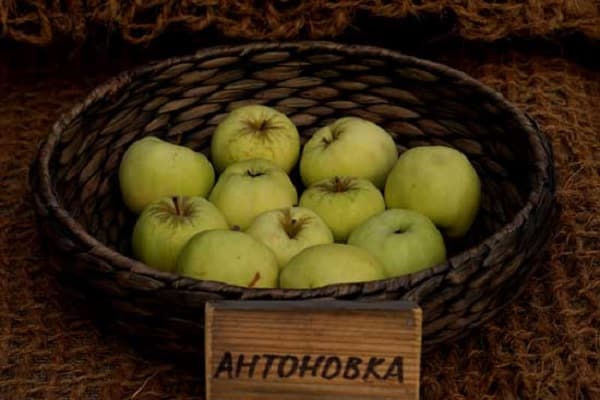

Gold
Antonovka ripens in the last decade of August, according to the ripening period it is included in the group of late summer varieties. The fruits are not stable. Unlike other varieties, the taste does not become more intense during storage. The average weight of the fruit is in the range from 150 to 180 g. The peel on the apples is straw-yellow. It begins to bear fruit 5 years after planting. The advantage of Antonovka Zolotoy is the resistance of the variety to the scab pathogen.
Antonovka New
Breeding by S.F. Chernenko, the variety was created for cultivation in the Central regions of the Russian Federation and the gardens of the Chernozem region. Antonovka ordinary and wonderful apple tree of national selection Babushkino were taken as genetic material. The maximum productivity of Antonovka Novaya was recorded at the level of 445 kg, the usual indicators of apple yield range within 200 kg.
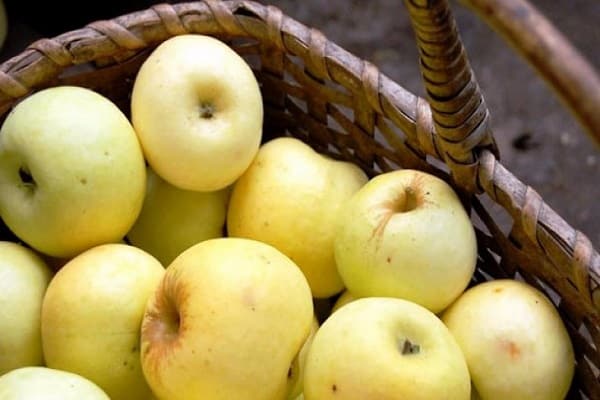

The plant is tall, its height is from 5 to 6 meters. The crown of Antonovka is wide, up to 8 m, spreading, not prone to thickening, has a rounded shape. Fruit characteristics:
- weight up to 120 g, individual copies up to 200 g;
- the skin is light yellow;
- blurred blush, red;
- the structure of the pulp is dense, the color is white, juiciness is present;
- classic sweet and sour taste, spicy notes are present;
- moderate aroma;
- the shape is onion, regular, there is a slight ribbing.
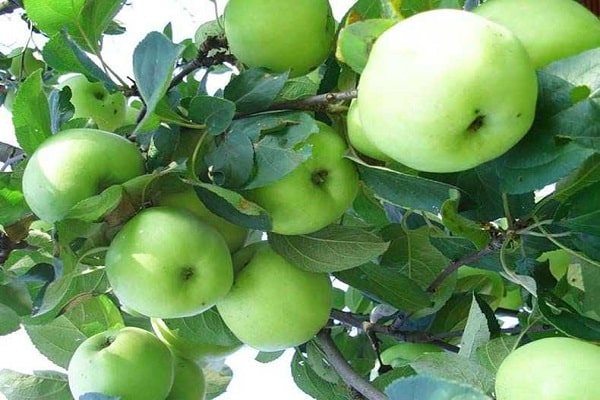

The beginning of fruiting of an apple tree falls on the 4th or 5th year of life. The collection time of Antonovka is from late September to mid-October. Consumer ripeness begins in November-December, fruits are stored until February. Advantages of Antonovka Novaya: winter hardiness, productivity. The disadvantage is susceptibility to scab.
Gardeners growing Antonovka give a positive assessment of the adaptive abilities of the apple tree. The productivity of trees depends on the climate and the quality of summer and autumn care. The harvest is stored for a long time and serves as an excellent raw material for jams, preserves, liqueurs, liqueurs, and the recipe for soaked apples was invented specifically for Antonovka.
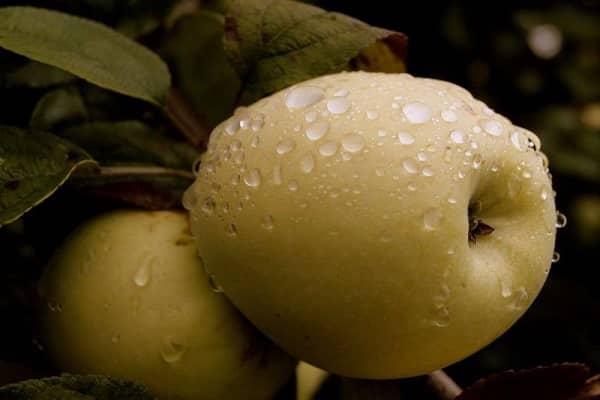

Description of fruits
For the most part, the fruits of the Antonovka variety are large and round. Ribs at the bottom of the apple can sometimes be seen. In the process of ripening, the fruits are colored green-yellow, and when stored for a long time, they turn yellow.
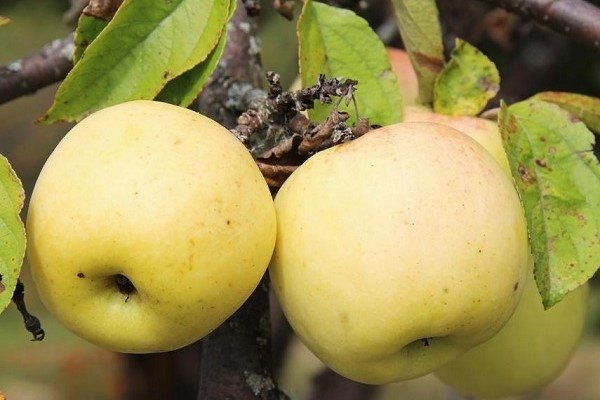

The pulp is light and sweet with a sour taste; this taste distinguishes Antonovka from other apple trees and is highly appreciated by tasters. The fruit gives off a characteristic pleasant aroma.
The fruit saucer is deep enough, and the fruit stem is thickened. The weight of an apple ranges from 120 to 140 grams, the record figure being 300 grams.
You can store the harvested apples for about 3 months, and under properly organized conditions and 4. Basically, the period depends on the region of growth of Antonovka - the fruits obtained from the northern regions remain in a usable condition longer.
Possible growing difficulties
Sometimes the Antonovka apple tree can succumb to the effects of such pests and diseases as:
- moth - the fruit is harmed by caterpillars of the moth, which gnaw through the flesh and lead to rotting apples. An effective method of pest control will be the treatment of trees with the help of such drugs as "Koragen" (0.2 ml of working solution per 10 liters of water), "Aktara" (0.01 g / 1 m²), "Confidor" (0, 2 l / 1 ha);
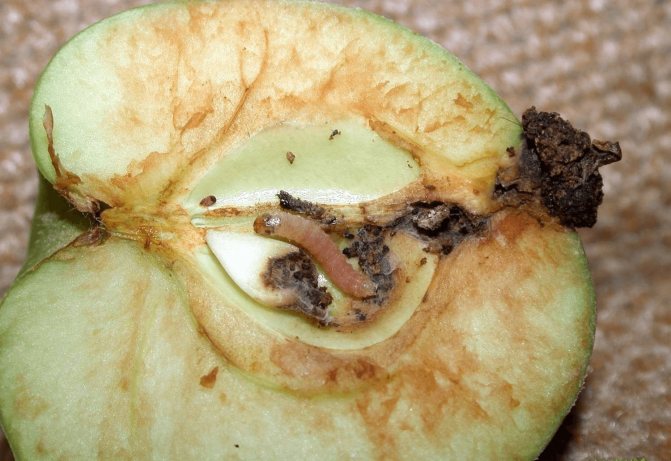

- powdery mildew - appears as a white coating on leaves and shoots, as a result of which the foliage curls, dries up and falls off. Effective against this disease will be a 2% solution of colloidal sulfur (20 g per 10 l of water), a 3% solution of Bordeaux liquid, "Topaz" (10 ml per 10 l of water), a solution of potassium permanganate (3 g per 10 l of water);
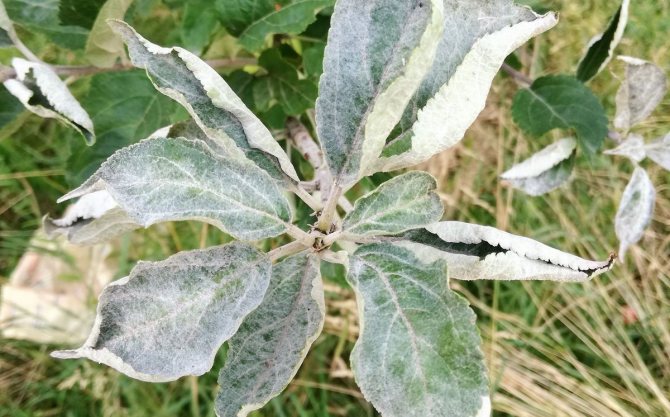

- fruit rot - a fungal disease characterized by the appearance of small dusty bubbles on the apples, which grow over time and affect the whole fruit. 3% Bordeaux liquid, “Fundazol” (10 g per 10 l of water), “Horus” (2 g per 5 l of water), “Azofos” (working solution 100 ml per 10 l of water) help to destroy it;
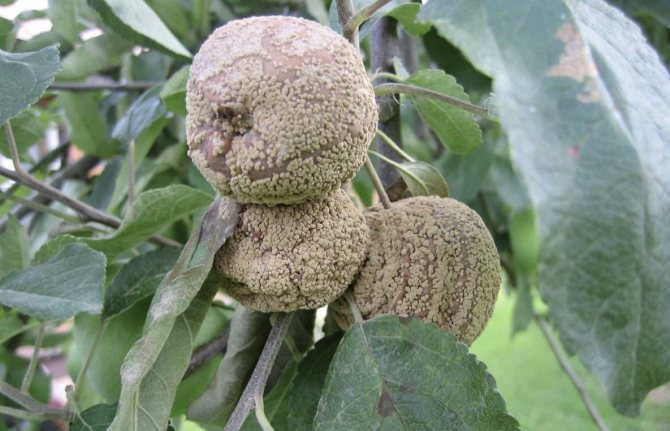

- scab - appears on the leaves and fruits of trees in the form of small spots of yellow-green color, which later turn black and crack. Against this disease, it is recommended to use a 2% solution of colloidal sulfur, 1% solution of Bordeaux liquid, the drug "Gamair" (10 tablets per 10 liters of water), "Horus" (2 g per 10 liters of water);
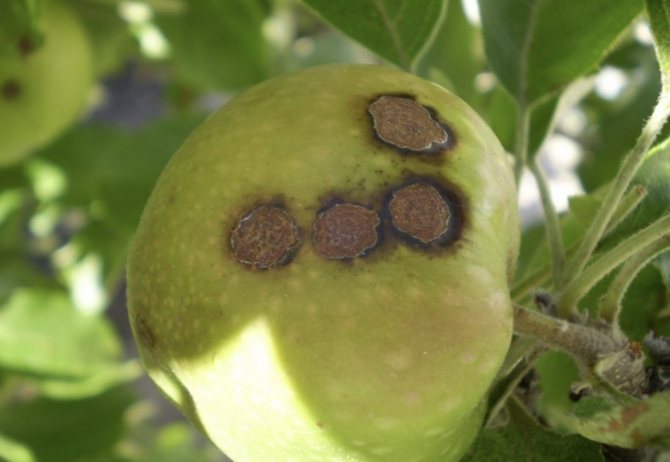

In addition to spraying trees with special solutions, it is also necessary to constantly carry out sanitary pruning of the crown, destroy diseased branches, foliage and weeds that may contain sources of infection, add organic and mineral fertilizers in a timely manner, and whitewash the trunks.
Yield
The amount of harvest increases as the plant matures. For example, if a tree is 20 years old, then you can get up to 200 kilograms of fruit, although some gardeners say that they achieved a harvest of up to 1000 kilograms (from one tree!). At first, fruiting is regular, but gradually it becomes periodic - once every 2 years.
Ripening of fruits occurs towards the end of September. The most important thing is to harvest the crop before the first frost, because you can let it ripen in the basement or any other cool room. The apples are ready for picking when their color acquires a yellowish color, but the texture should be firm.
For a longer storage of fruits, it is recommended to pick them by hand, as they are damaged when the tree is shaken.
The need for a transplant
Unless absolutely necessary, it is better to refrain from transplanting a young tree, since at best this will increase the start of fruiting. In the worst case, the roots will not have enough time to take root in the new place, and severe frosts in winter or drought in summer can lead to the death of the tree.
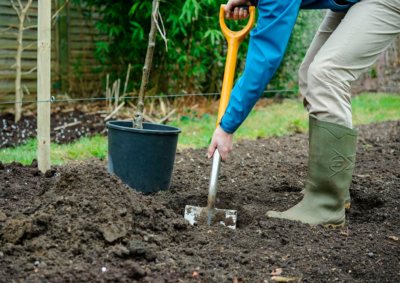

If you can't do without a transplant, you should do it in late autumn. (but a few weeks before the onset of frost) or in early spring before the leaves appear.
- The tree must be dug out with a large clod of earth (the diameter of the clod should be approximately equal to the diameter of the crown).
- Drag gently on the piece of burlap to the new location.
- The pit should be prepared in advance according to the same principle as for the initial planting of the seedling.
Diseases and pests
Experts are of the opinion that Antonovka's immunity and its ability to resist pests depends on the region of growth. For example, if a tree grows in a city with a cold and humid summer, then it can suffer from scab, and in warm areas it is often affected by powdery mildew.
If we talk about pests, Antonovka is afraid of the apple moth, which infects apples.Also, the plant can infect the apple blossom beetle, aphids, scale insects. Still, parasites do not attack this variety very often.
There are several preventive measures to protect the plant from these diseases and most pests:
- Collection and destruction of fallen leaves in the autumn.
- Thorough digging of soil in the area of trunk circles before cold weather.
- Whitewashing - trunks and skeletal branches are processed.
- Treatment with a 3% solution of copper sulfate of the crown and soil in late autumn or early spring.
- Use of pesticides in early spring before sap starts moving.
- Installation of trapping belts.
- Preventive treatments with insecticides. The first is carried out before flowering, the second - after it, the third - 10 days after the second.
- Preventive treatments with fungicides to prevent scab, powdery mildew, and so on.
Site selection and preparation
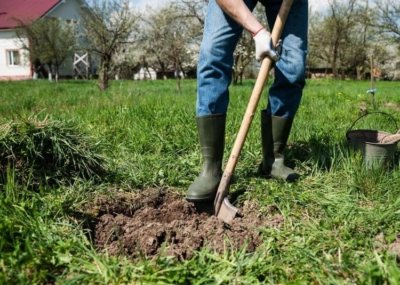

The best soil will be loamy or sandy loam soil with normal acidity.... If the soil is too acidic, you can deacidify it with dolomite flour or lime.
Since the apple tree does not like excessively moist soil, the planting site should be chosen on a hill, or you need to take care of good drainage around the apple tree, otherwise this can negatively affect the plant. It is also important to choose a well-lit place - shading can reduce the sugar content of apples and generally reduce the volume of the harvest.
You need to prepare the pit a few weeks before planting, if the planting itself is planned in the fall. If the event is planned for the spring, it is better to prepare the pit in the fall.
The pit must be 1 m wide and at least 80 cm deep:
- Sod is laid at the bottom and watered abundantly.
- Next, fertile soil (peat) is added, mixed with mineral fertilizers (superphosphate, potassium sulfate, potassium salt are suitable) and organic (compost or manure). The thickness of the fertile layer must be at least 20 cm.
- Next, the seedling is placed in a hole, carefully distributing the roots. It is extremely important to leave the root collar 8-10 cm above the ground.
- At the end, the seedling must be watered abundantly with water (about two buckets).
Since Antonovka grows with a spreading crown, it is better to leave the distance to other trees, fences or outbuildings at least 6 m.
Advantages and disadvantages
Antonovka has several indisputable advantages, thanks to which many gardeners plant it on their site:
- impressive productivity;
- unique taste and aroma;
- high marketability of fruits;
- unpretentiousness and resistance to frost;
- excellent adaptability to different regions;
- fruits are a good antioxidant.
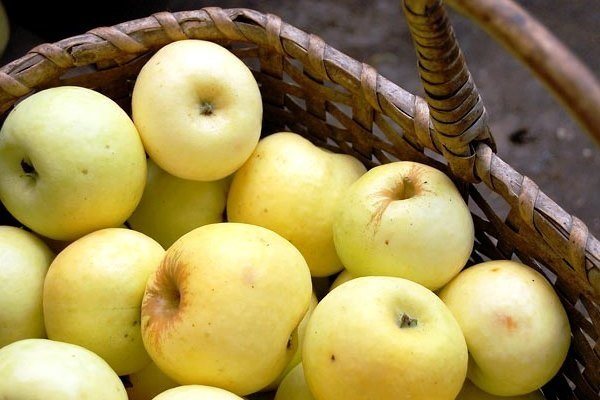

Of course, there are also disadvantages:
- fruiting periodically;
- afraid of scab and moth;
- in the southern regions, the shelf life of the crop is short.
Storage
Basic recommendations to extend the shelf life of plucked apples without losing their presentation and taste:
It is forbidden to shake apples from the tree, as this will lead to rapid rotting of the fruits in the places of impact. Fruits for long-term storage should be removed a little before they reach technical maturity.
Before harvesting, reusable containers are fumigated or sprayed with a solution against fungal crops, and then dried.
When placing apples in a transport container, avoid hitting the fruit against each other or against the walls of the container. Before being sent to a cellar, warehouse or storage, apples are calibrated, get rid of fruits that have even the slightest damage on the peel.
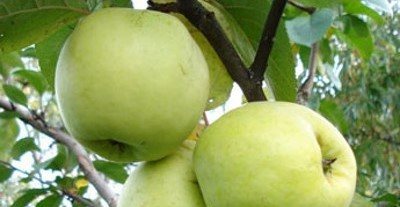

Sorted fruits are stored in wooden, plastic boxes with shavings or wrapped in a separate sheet of paper, tracing paper.
The optimum air temperature in the room where apples are stored: 1.4-1.8 ° C.
The presence of a functioning ventilation system increases the keeping quality of fruits.
Landing
Antonovka is planted in early spring, for this they take a one- or two-year-old seedling purchased in the fall.Until spring, it is left in the basement at a temperature of 0 to 5 degrees Celsius.
Since the crown will have a large diameter, the distance between adjacent plants should be at least 5 meters. As for the best landing site, a small southern slope, sheltered from the icy wind, is suitable. In this case, the apple tree should receive enough sunlight.
The roots need loose soil; loam, sandy loam or black soil is best suited. The dimensions of the landing pit should not exceed a depth of 70 centimeters and a diameter of 1.2 meters.
To fill the planting pit, a mixture of black soil, humus or compost, peat and sand is made in equal proportions. 30 grams of superphosphate and 300 grams of wood ash are added to each bucket. The pit is harvested in the fall and covered with waterproof material.
Step-by-step planting instructions
- Soak the root system of a young plant for 3 hours in water.
- Open the hole and remove some of the soil so that the roots of the apple tree fit inside.
- Make a mound at the bottom of the hole and drive in, stepping back from the center, a peg made of wood up to 1.2 meters high.
- Sprinkle the roots of the seedling with Kornevin powder. Lower the apple tree into the hole so that the root collar is at the top of the knoll. Spread the roots.
- Fill the hole with soil that was removed from it. The root collar must remain at ground level.
- Tie the stem of the seedling to the peg and form a near-stem circle.
- Water the apple tree generously, cut off the top at a distance of 80 centimeters from the ground. Cut the branches by 20 centimeters.
- After a couple of days, loosen the soil and mulch (a layer of mulch up to 15 centimeters).
Features of the plant and fruiting
The tree is vigorous, can reach a height of 8 meters. The natural shape of the crown is raised, in the form of an irregular oval, becomes spreading with age. The main branches are covered with brown bark, well overgrown with branched ringlets. About 50-60% of the crop ripens in the plots of branches at the age of three to four years... Fruiting is often observed on two-year-old wood. Flowering is late, therefore, it is less susceptible to the threat of recurrent frosts.
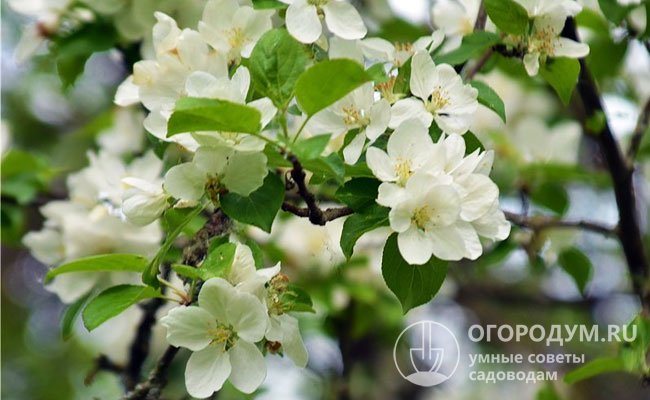

The flowers are large with white-pink oblong petals adjacent to each other
The plant is characterized by good bud awakening and moderate branching ability, so trees need relatively little pruning. Shoots are brown, characterized by pronounced geniculation, usually curved. Leaves with a wrinkled surface, bright green, ovate with a rounded base and serrated (serrated-crenate) edges.
Early maturity is assessed as low. According to experts, trees after budding begin to bear fruit in the 7-8th year and in 1-2 years they bring a high marketable yield.
In the first years, flowering and fruiting are regular, then periodic. According to the reviews of experienced gardeners, with proper care and timely rejuvenating pruning, fruiting is stabilized, and the productivity of a 20-year-old tree can be up to 328 kg.
In the Central region and to the north, the variety is considered winter, south of the Bryansk-Orel-Lipetsk-Michurinsk line - late autumn. Apples are usually picked in mid to late September.
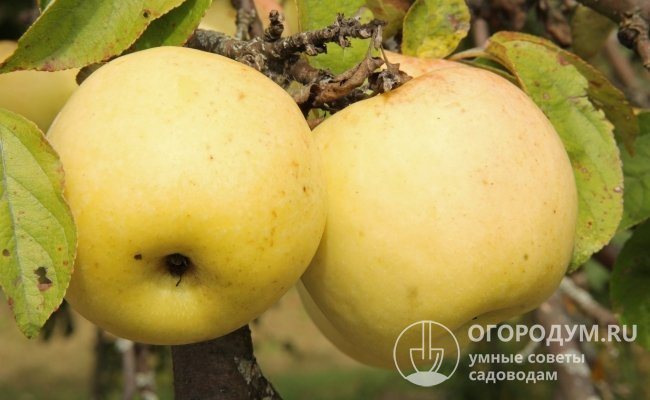

Until removable maturity, the fruits are firmly adhered to the tree thanks to the thick short stalks
Under normal conditions, the average long-term yield is 200 c / ha or more, of which 90-91% falls on the share of fruits with high marketability. There were cases when more than 500 and even 1000 kg of apples were obtained from individual trees.
Fruit characteristics
Fruits are uniform, large and medium in size: weight - 120-150 g, maximum - up to 300 g... Apples are flat-rounded or oval-conical; there are specimens of a cylindrical shape. Ribbing is present on the entire surface. The skin is smooth, “rusty” in the depth of the funnel and beyond. Numerous subcutaneous punctures are white, large, well visible at the apex.The color of the skin at the stage of technical maturity is greenish-yellow, during storage it becomes light straw-yellow without a cover blush or with very weak watercolor stains. Occasionally, a pale pink or brick top coat is observed, as well as a golden tan.
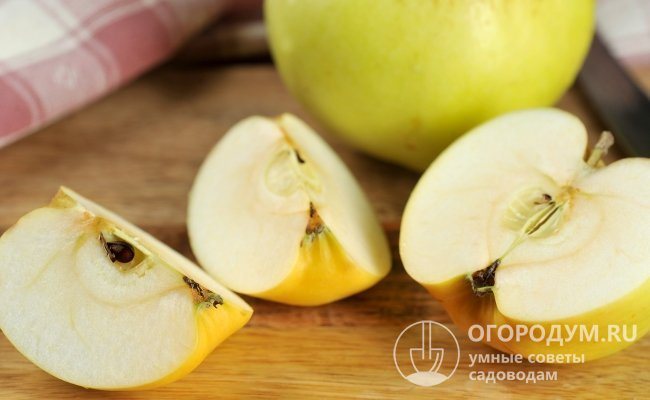

The pulp is yellowish, juicy, not very dense, granular; sweet and sour taste with some excess acid
By the strength of the aroma, Antonovka apples are still superior to almost all the others and that is why they are so popular. Professional tasting assessments of taste - 4.5-4.8 points (out of 5). Many summer residents call the taste "unique" sweet and sour, with a refined specific aroma.
The taste of fruits and berries is determined by the ratio of the sum of sugars and titratable acids, the so-called sugar-acid coefficient, the optimal value of which is 15-20. According to the results of studies carried out by VNIISPK specialists, this indicator for Antonov apples is at the level of 11.5 (sugar - 9.22-10.82%, acids - 0.94-1.0%), which explains their pronounced sourness.
Biochemical analysis of fruits also confirms the high content of pectins (14% on dry weight), vitamins and biologically active substances in their composition:
| Useful material | Quantity in 100 g of raw product |
| Vitamin C (ascorbic acid) | 12.1-17 mg |
| P-active leukoanthocyanins | 281 mg |
| P-active catechins | 146.6 mg |
| Tannins | 41 mg |
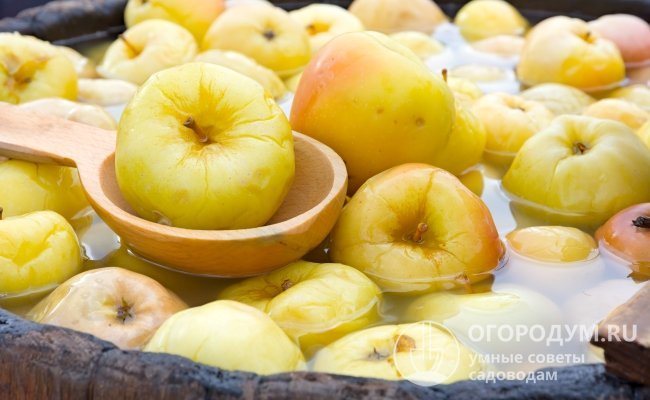

Apples are intended for fresh consumption and various processing methods, traditionally used for pickling (urinating)
Fruits of universal purpose, well tolerate transportation and storage, the terms of which are 2-3 months. As it ripens, the taste of the fruit improves, becomes more pronounced and sweeter.
Care
Antonovka, in general, is unpretentious, so she does not need complex care. Of course, the tree needs moisture for good fruiting, but watering must be in moderation, otherwise the plant will suffer from excess water. The optimal frequency is once every 2 weeks, 30 liters per individual. In the heat, the frequency is doubled.
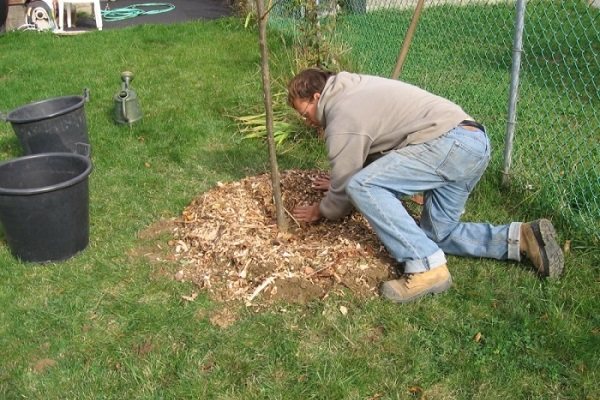

It is also very important to arrange proper care in the first year. It consists of the following:
- feeding the apple tree;
- protection against parasites and diseases;
- loosening the soil 2 times a month, removing weeds;
- adequate watering;
- pruning.
Another important nuance is mulching. When the plant becomes an adult, you can sow green manure in the near-stem circle.
Features of seasonal apple care
"Antonovka ordinary" is a non-capricious variety, however, there are some requirements to be observed when caring for trees. Let's find out what an apple tree needs for fast growth and abundant fruiting.
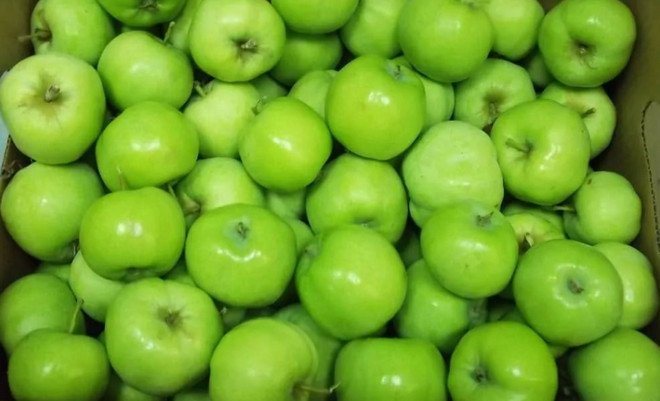

Soil care
For the first seven years after planting an apple tree, it is necessary to regularly remove grass and any other plants from the soil, performing weeding every time after watering.
As for the latter, it is performed twice a week, pouring at least a bucket of water under each tree. In a very dry season, the regularity of watering, as well as the volume of the applied liquid, is increased.
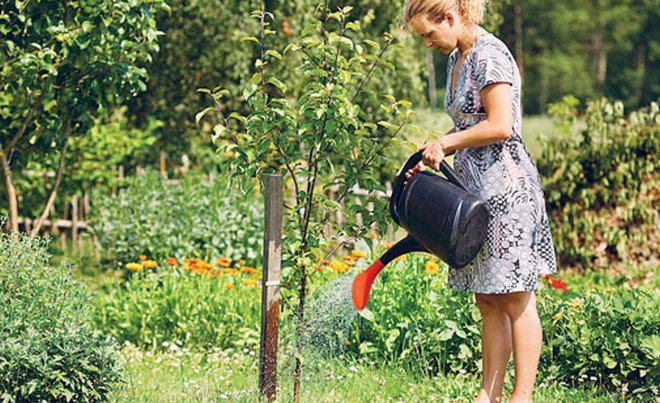

During the spring and autumn digging of the soil in the near-trunk circle, you can feed the apple tree with mineral compounds: superphosphate, potassium chloride and wood ash.
Mulching the soil with sawdust, humus and rotted manure (the optimal layer thickness is 8 cm) will help to preserve moisture in the soil and protect the plant from drying out the root system.
Fertilization
Fertilizers for Antonovka are applied three times a year: after the snow melts (that is, in early spring when digging the soil around the tree), before its flowering and during the formation of fruits on the branches.
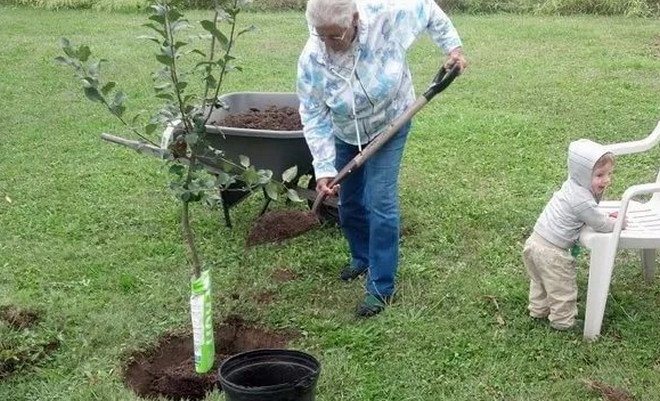

Any mineral fertilizers are suitable for feeding, but if you use organic matter (for example, slurry or chicken droppings), do not forget that it must be fermented and diluted with water in a ratio of 1:10.
Important! Always follow the dosage carefully, as over-feeding can damage the root system.
Disease and pest control
Despite its high resistance to diseases and pests, during periods of strong epiphytoties, the susceptibility of Antonovka to scab can increase to average levels, therefore, in order to protect it (and at the same time yourself) from possible problems, it is very important to use preventive treatments with fungicidal compositions.
Against apple diseases they use: "Antrakol", "Delan", "Poliram", "Topsin", "Skor". To get rid of the moth and other pests will help: "On the spot", "Fastak", "Kemifos", "Decis", "Calypso", "Karbofos".
Chlorophos, pure Entobacterin, or a mixture of Entobacterin and chlorophos can be used to protect against the moth and other caterpillar species.
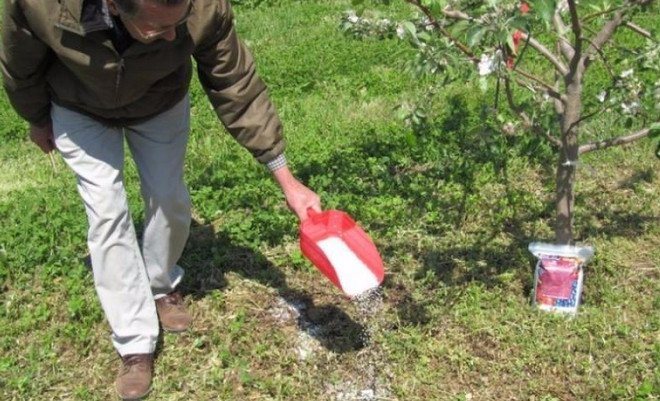

Preventive measures to combat diseases include spring treatment of Antonovka with 3% Bordeaux liquid and spraying the soil with 0.3% Nitrafen solution. After the first buds appear, the tree can be treated with 0.5% copper oxychloride.
Pruning and shaping the crown
Starting from the second year of life, the main component of caring for "Antonovka Obytochnaya" is the constant pruning of weak or dead branches and periodic formation of the crown of the tree. The trunk of the apple tree can also be shortened, with the removal of 1/3 of all new branches.
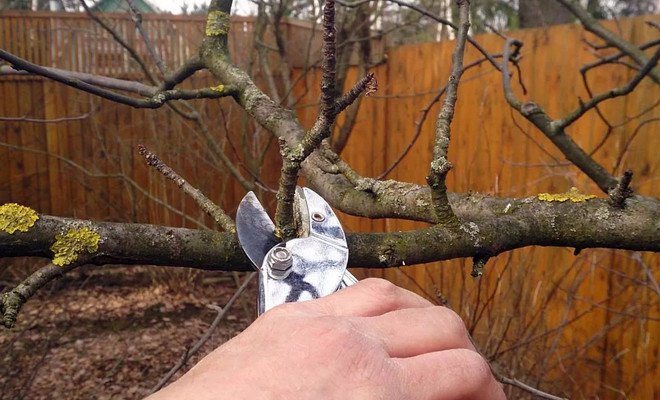

With the beginning of fruiting, the shortening of lateral shoots does not stop, although the intensity of the process should decrease slightly. When the tree reaches twenty years old, cut from ½ to 1/3 perennial ringlets.
The more of them on the tree, the more you need to remove. In addition, do not forget about the annual pruning, which includes the removal of damaged, dry, crooked, diseased and growing close to the rest of the branches.
Top dressing
The apple tree needs feeding 4 times a year. The fertilization scheme is very simple:
- For the first time, feeding is done in the spring, before flowering. Urea is used for this (from 50 to 500 grams, depending on the size and age of the tree). Spread fertilizer over the soil under the crown.
- As soon as the flowers are tied, the apple tree is fertilized with potash and phosphorus compounds, slurry and urea.
- In the process of fruit ripening, nitrogen fertilization should be applied.
- The last time fertilization is applied after picking apples. Potassium and phosphorus are used.
How to choose planting material and when to root?
The best time for planting in chernozem soils is autumn (until the end of October), in other regions - spring, before bud break (in late April or early May).
Saplings should be chosen 2-3 years old, with well-developed roots.
1-2 days before planting, it is worth placing the seedling in water, and immediately before planting, for 1-2 hours, you can put the seedling in a solution with a diluted growth stimulant. This will increase the survival rate of the young tree.
Pruning
It is very important to adequately form the crown in the first years of the apple tree's life. For a traditionally tall tree, a sparse-tiered crown shape is used, maintaining growth at a level of 5 meters.
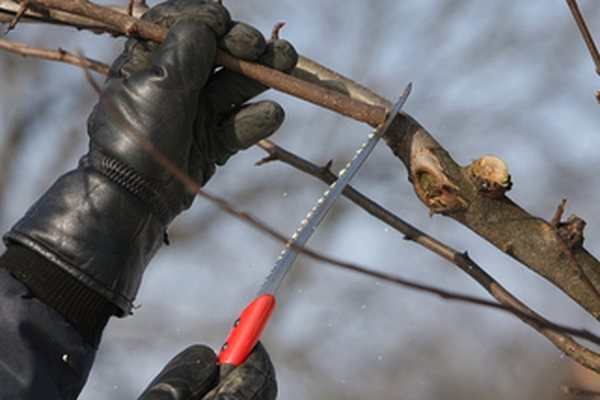

You also need to resort to regulating pruning, which allows you to thin out the crown. To do this, cut branches growing inside the crown and upward, and also cross.
In the autumn, sanitary pruning is carried out every year, getting rid of dry, injured and painful branches.
How to plant Antonovka on the site
Growing Antonovka will not be difficult even for a novice gardener. Trees survive, bloom and bear fruit even in the absence of maintenance, in poor soils and in adverse conditions. However, in order to get a plentiful and high-quality harvest every year, varietal requirements should be taken into account.
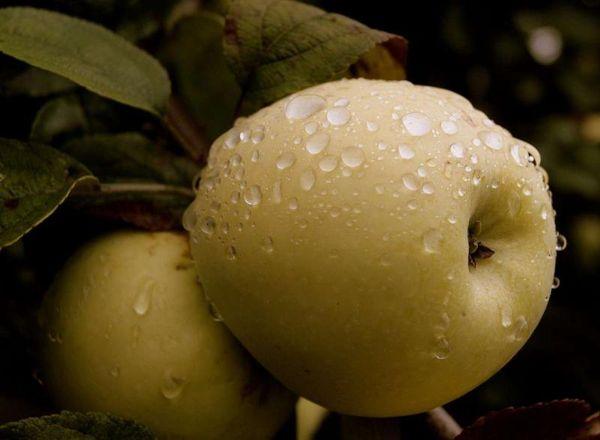

What to Consider
The principles of proper landing require taking into account:
- the quality of the planting material;
- landing dates;
- suitable conditions;
- technology and planting schemes.
Optimal location
A suitable place for growing Antonovka is characterized by:
- good illumination;
- the occurrence of groundwater at a level of 2-2.5 m;
- moderate moisture;
- good drainage.
Required soil composition
Characteristics of soil for planting Antonovka:
- high air permeability;
- acidity within 5.6-6.0 pH;
- sandy loam, loam, floodplains or leached chernozems.
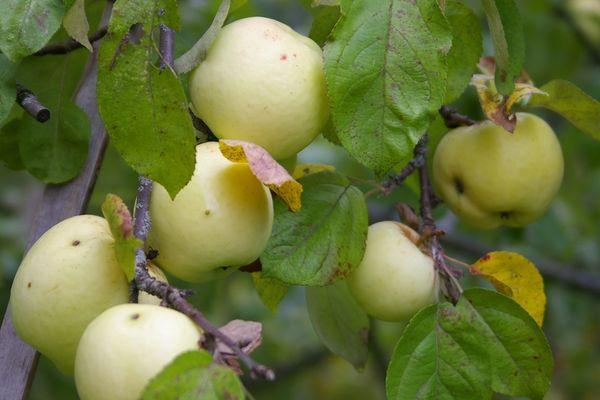

Favorable and unwanted neighbors
You can plant next to apple trees:
- pine trees;
- larch;
- tomatoes,
- calendula;
- dill.
Due to competition for light and water, you should not plant next to apple trees:
- apricots;
- cherries;
- cherries;
- peaches.
Poplars emit essential vapors unfavorable for apple trees, and mountain ash has common pests - the mountain ash moth.
Terms of planting works
It is preferable to plant Antonovka apple trees in the fall, but not later than the end of October. In case of a forced planting in the spring, it is worth completing the work by the end of April.
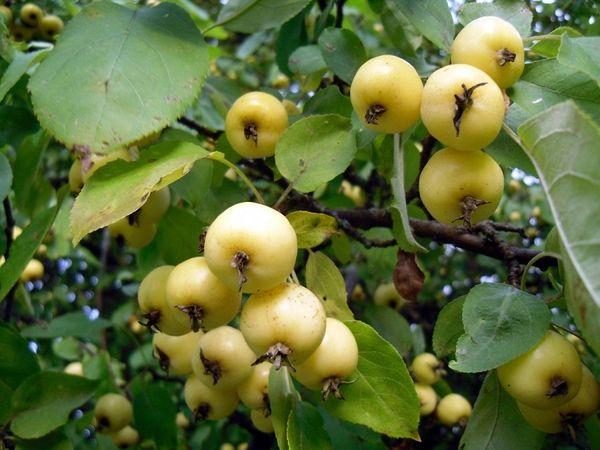

Preparing the planting pit and seedling
The planting hole should be prepared 4-8 weeks before planting or in the fall for spring planting. The pits should be about 1-1.2 m across and 0.6 m deep. The land must be folded separately and cleared of weeds. The day before planting, the roots of the seedlings must be placed in water, where a small amount of growth stimulants can be dissolved.
Tree layouts
The distance between the seedlings depends on the rootstock and the total height of the apple tree:
- The vigorous type is planted at a distance of 4-4.5 m and 4-6 m between rows.
- Medium-sized ones can be planted 3.5-4 m apart with a gap of 4-4.5 m in rows.
- Semi-dwarf ones are located no closer than 3-3.5 m and a row spacing of 4-4.5 m.
- Dwarf ones can be placed at a distance of 2.5-3 m between trees and 3.5-4 m between rows.
Landing technology
The process of planting seedlings:
- Mix the soil from the planting pit with humus, peat, sand and black soil in different proportions.
- Add 30 g of superphosphate and 250 g of ash to the bucket.
- Form an earthen hill at the bottom.
- Drive in 1 or 2 support pegs at some distance from the center.
- Place the roots on an earthen mound.
- Cover with soil mixture to the level of the neck.
- Compact the soil.
- Tie the trunk to the supports.
- Sprinkle with plenty of water.
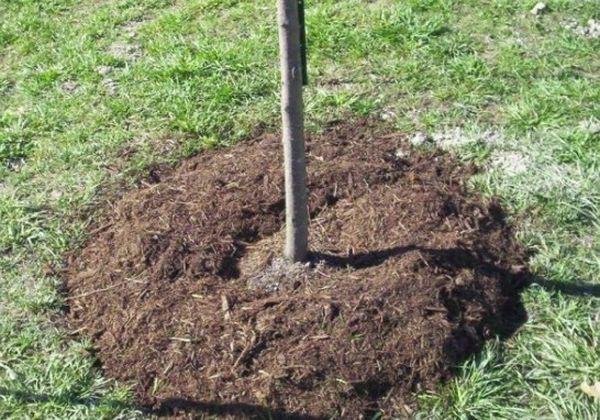

Testimonials
Margarita, Orekhovo-Zuevo: I believe that no orchard can exist without Antonovka. I myself grow several varieties of this culture. I really like the quality of the apples, the only thing is that they often crumble, and fruiting has become periodic over time.
We collected more than 10 buckets of fruit for the last time and distributed them to relatives and neighbors. Good juices and jellies are obtained from Antonovka. Since we live in the southern region, our harvest is stored for a little more than a month, so I recommend that all southerners eat apples as soon as possible or send them for processing.
Anton, Piskov: My parents planted Antonovka at our dacha, even when I was a child. For many years now, the apple tree has been pleasing us with a huge harvest, although sometimes there are years when it does not even produce an apple. The taste is beyond words, delicate, rich, with sour notes. Of all the apples that I have tried, it is Antonovka that I like the most.
Children also love these fruits, they gobble up on both cheeks. The wife makes jam or jam from the remnants of the harvest, it turns out very tasty. The fruits are stored well, the last time they lay in our basement almost until winter.
Growing in different regions
In the suburbs and North-West of Russia
Here the Antonovka variety is like grapes for Georgia. It has been growing for a long time. They are called differently. And it’s not the same everywhere. A garden cannot be imagined without her. And new varieties are being developed.
You can see in the video below that Antonovka in the Moscow region feels great:
In the Urals and Siberia
It is very widely used, but it is in greenhouses with weak rootstocks and stale molds outside greenhouses. The climate forces us to look for acceptable forms. And clone varieties of Antonovka.
In Ukraine
Northern areas only (Sumy, Chernigov, Kiev regions) it is grown. But it is more like a late autumn variety. And for growing seedlings for grafting.
Varieties and descendants
Even in the book of the XIX century. mentioned about 17 subspecies of Antonovka ordinary. In 1929 I.V. Michurin argued that out of 26 varieties, only 5 can be considered reliable subspecies. Today, the most famous varieties are:
- "Golden monk";
- dessert;
- onion;
- gray (rusty);
- white;
- stone (red-sided);
- gold.
All of them, being basically similar to the classic look, have some differences. Considered a clone, the "Golden Monk" begins to bear fruit from the seventh year. Differs in early flowering and excellent harvest. Harvesting of fruits begins earlier - in mid-August, but their shelf life does not exceed a month.
The dessert subspecies was obtained by crossing the base variety with Pepin saffron. Begins to bear fruit later - at 4–5 years. These fruits are larger, with a red "blush" clearly visible in the photo. They can be stored longer.
The onion sub-variety is so named for the similarity of the fruit to the turnip. The tree is very durable and often bears fruit even at 120 years. The harvested fruits are stored for a long time. Behind the very unassuming appearance of the gray variety, its amazing survival rate is hidden: according to reviews, trees do not require the care of a gardener at all. In addition, they are distinguished by excellent yield, transportability and keeping quality.
The fruits of the white sub-variety differ not only in color, but also in their large size and lower keeping quality. By mutation of this variety Michurin received a six-hundred-gram (one and a half pound) Antonovka. The weight of its fruits is 250-600 g.
Kamenichka is characterized by greenish-white flesh, very high yield and high keeping quality. The "golden" variety is much sweeter and ripens not in autumn, but in summer.
The Antonovka apple variety is one of the "parents" of some other successful apple varieties (Bogatyr, Imrus, Vishnevaya). They are winter-hardy, even more resistant to scab and have a longer period of regular fruiting.

